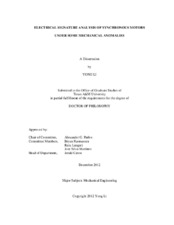| dc.description.abstract | Electrical Signature Analysis (ESA) has been introduced for some time to investigate the electrical anomalies of electric machines, especially for induction motors. More recently hints of using such an approach to analyze mechanical anomalies have appeared in the literature. Among them, some articles cover synchronous motors usually being employed to improve the power factor, drive green vehicles and reciprocating compressors or pumps with higher efficiency. Similarly with induction motors, the common mechanical anomalies of synchronous motor being analyzed using the ESA are air-gap eccentricity and single point bearing defects. However torsional effects, which are usually induced by torsional vibration of rotors and by generalized roughness bearing defects, have seldom been investigated using the ESA.
This work presents an analytical method for ESA of rotor torsional vibration and an experimentally demonstrated approach for ESA of generalized roughness bearing defects. The torsional vibration of a shaft assembly usually induces rotor speed fluctuations resulting from the excitations in the electromagnetic (EM) or load torque. Actually, there is strong coupling within the system which is dynamically dependent on the interactions between the electromagnetic air-gap torque of the synchronous machine and the rotordynamics of the rotor shaft assembly. Typically this problem is solved as a one-way coupling by the unidirectional load transfer method, which is based on predetermined or assumed EM or load profile. It ignores the two-way interactions, especially during a start-up transient. In this work, a coupled equivalent circuit method is applied to reflect this coupling, and the simulation results show the significance of the proposed method by the practical case study of Electric Submersible Pump (ESP) system.
The generalized roughness bearing anomaly is linked to load torque ripples which can cause speed oscillations, while being related to current signature by phase modulation. Considering that the induced characteristic signature is usually subtle broadband changes in the current spectrum, this signature is easily affected by input power quality variations, machine manufacturing imperfections and the interaction of both. A signal segmentation technique is introduced to isolate the influence of these disturbances and improve the effectiveness of applying the ESA for this kind of bearing defects. Furthermore, an improved experimental procedure is employed to closely resemble naturally occurring degradation of bearing, while isolating the influence of shaft currents on the signature of bearing defects during the experiments. The results show that the proposed method is effective in analyzing the generalized roughness bearing anomaly in synchronous motors. | en |


